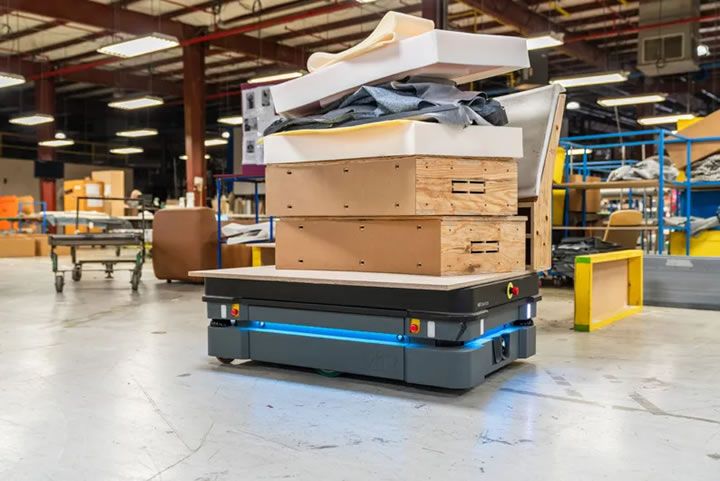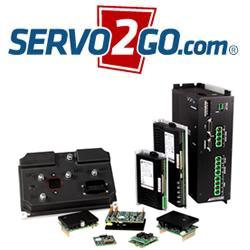Jasper Group turned to a systems integrator, Robotic Solutions, LLC, to help them consider using autonomous mobile robots (AMRs) for material handling in a plant of more than one-million square feet of manufacturing space.
 Jasper Group Using AMRs for Material Handling
Jasper Group Using AMRs for Material Handling

Case Study from | MiR
Indiana-based Jasper Seating Company Inc., part of the Jasper Group is a manufacturer of wood furniture and accessories, serving hundreds of education, corporate, dining and government customers with high quality furniture products–ranging from tables and casework to seating and office desks.
Jasper Group turned to a systems integrator, Robotic Solutions, LLC, to help them consider using autonomous mobile robots (AMRs) for material handling in a plant of more than one-million square feet of manufacturing space.
The Project
Delivering raw materials from the shipping and receiving location to its production operations in the expansive Orleans plant was a manual-intensive process. Multiple shuttles ran daily throughout the plant that were managed by employees who drove golf carts to deliver raw materials and other parts to JSI production lines. “You can imagine how time-consuming that job was,” said Jeff Harris, Jasper Group’s vice president of Operations. “We were transferring parts and raw materials from one end in our 1.4 million square foot building to production lines on the other side. It felt like the materials were never there when you needed them, and so, it was an ideal process to optimize with technology. We wanted to better organize the material handling processes and not waste anyone’s time going back and forth in the plant.”
President of Robotic Solutions, Rick Braun, had previously brought an autonomous mobile robot (AMR) demo unit to the factory floor for a test run, and some two dozen Jasper Group employees observed the demonstration. “There was a lot of attention, a lot of excitement,” Rick said. From there, Robotic Solutions collaborated with Jasper Group on an MRG application to automate the material handling process. Once the project was approved, Robotic Solutions delivered three MiR Mobile Robot 600 units to the Orleans plant, including the hardware and integrated software. Their head engineer and product manager spent a few weeks with Jasper’s production staff to train and upskill them on how to both operate and maintain the AMRs. Following the training, Jasper’s employees took control and began to schedule automated routes for the AMRs. “A lot of the work is on their end,” Rick said. “The AMRs must fit their needs. We give some guidelines and estimates based on the distances from Point A to Point B. I think three is a good start, but they might find out after another year that they need to add another AMR.”
Jim Alberts, Jasper’s senior director of Continuous Improvement, and Jeff did significant pre-planning, too. “We tried to flush out everything we thought would be an issue,” Jim said. One of Jasper’s lead continuous improvement engineers, Andy Rostron, carried out the bulk of the internal set-up work, creating and simplifying dashboards to track the AMRs. The autonomous mobile robots now run nonstop from the start of the day through the end of the shift, without any downtime. The robots can carry up to 1,250 lbs on each continuous cycle from receiving and shipping to production and back to receiving with empty carts. They can detect obstructions and stop or re-route around the obstruction, increasing safety and efficiency within the plant. Those benefits alone can increase lead times and on-time performance.
The Project
Delivering raw materials from the shipping and receiving location to its production operations in the expansive Orleans plant was a manual-intensive process. Multiple shuttles ran daily throughout the plant that were managed by employees who drove golf carts to deliver raw materials and other parts to JSI production lines. “You can imagine how time-consuming that job was,” said Jeff Harris, Jasper Group’s vice president of Operations. “We were transferring parts and raw materials from one end in our 1.4 million square foot building to production lines on the other side. It felt like the materials were never there when you needed them, and so, it was an ideal process to optimize with technology. We wanted to better organize the material handling processes and not waste anyone’s time going back and forth in the plant.”
President of Robotic Solutions, Rick Braun, had previously brought an autonomous mobile robot (AMR) demo unit to the factory floor for a test run, and some two dozen Jasper Group employees observed the demonstration. “There was a lot of attention, a lot of excitement,” Rick said. From there, Robotic Solutions collaborated with Jasper Group on an MRG application to automate the material handling process. Once the project was approved, Robotic Solutions delivered three MiR Mobile Robot 600 units to the Orleans plant, including the hardware and integrated software. Their head engineer and product manager spent a few weeks with Jasper’s production staff to train and upskill them on how to both operate and maintain the AMRs. Following the training, Jasper’s employees took control and began to schedule automated routes for the AMRs. “A lot of the work is on their end,” Rick said. “The AMRs must fit their needs. We give some guidelines and estimates based on the distances from Point A to Point B. I think three is a good start, but they might find out after another year that they need to add another AMR.”
Jim Alberts, Jasper’s senior director of Continuous Improvement, and Jeff did significant pre-planning, too. “We tried to flush out everything we thought would be an issue,” Jim said. One of Jasper’s lead continuous improvement engineers, Andy Rostron, carried out the bulk of the internal set-up work, creating and simplifying dashboards to track the AMRs. The autonomous mobile robots now run nonstop from the start of the day through the end of the shift, without any downtime. The robots can carry up to 1,250 lbs on each continuous cycle from receiving and shipping to production and back to receiving with empty carts. They can detect obstructions and stop or re-route around the obstruction, increasing safety and efficiency within the plant. Those benefits alone can increase lead times and on-time performance.
Listen To Your Workforce
 First, when thinking about bringing in new technology, especially robotics, Jeff advised to recognize that there are always pros and cons for process improvement. You should spend time with the people doing that work now and hear directly from them, why they do things a certain way and how see automation and technology supporting their role. “Get them onboard early. Communication is key; definitely spend time on that.”
First, when thinking about bringing in new technology, especially robotics, Jeff advised to recognize that there are always pros and cons for process improvement. You should spend time with the people doing that work now and hear directly from them, why they do things a certain way and how see automation and technology supporting their role. “Get them onboard early. Communication is key; definitely spend time on that.”
Second, Jeff said, “Consider using a qualified tech integrator to support your automation journey. A tech integrator can help avoid stumbling blocks and advise on purchases. They may also be aware of other— maybe better—solutions for what you want to accomplish with tech adoption.” One example of success was seen by top-level management at Jasper Group; they were amazed at how quickly the technology was integrated into the material handling process. “We actually filmed after one week so we could show it to them,” Jeff said. “And they came down here to watch it.” Rick chimed in: “It went about as smoothly as you could hope. But it’s great to hear that all the way up the chain, everyone agrees this was a big win for Jasper Group. I think it’s going to open doors to more, very interesting technology projects in the coming years,” Rick continued.
While there’s often an undercurrent of skepticism about workers being displaced by machines and robots, if that fear existed at Jasper Group, it was fleeting. Communication is a constant, Jeff advised. “You can’t talk to people too much about this kind of thing. We wanted to spend as much time as we could with our workforce, educating them about the tech project and how we planned to re-deploy them in our facility. Once they learned that the robots would take over the repetitive task of shepherding parts back and forth between receiving and the production line, their apprehension about automation began to fade.”
Jeff resumed, “Now everyone is feeling confident, and they all see the improvement in the process, too.” The robots began to take on personalities. So much so, that employees named the autonomous mobile robots. “It started as a little joke,” Jeff said. “But they eventually became known as Romeo and Juliet. It was all very theatrical.”
The Results
The project implementation goal, according to Rick, was to have the technology implemented within a few weeks and then hand the keys to the Orleans manufacturing staff. “But having said that, we don’t just walk away,” he said. “We stay with them for any troubleshooting and integration issues.” The project has been a great success, Jeff said. “We went from three people working eight hours a day to accomplish material handling, all of which is now augmented by the AMRs. Those workers were redeployed to other areas or departments within the plant.” In fact, Jeff said, they started with just two of the MiRs in use, but the system was functioning so well that they were ready to introduce the third just a few months later. It will be deployed in the upstairs upholstery production line.
The content & opinions in this article are the author’s and do not necessarily represent the views of RoboticsTomorrow
Comments (0)
This post does not have any comments. Be the first to leave a comment below.
Featured Product

